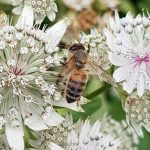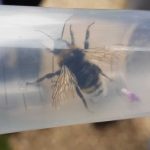15 people joined a bee walk led by Trevor Smith at The Vyne, a property of the National Trust, on Saturday 24th June. He started in the walled garden, discussing the life cycle of common bees and looking at the holes in the mortar which mining bees had used earlier in the year. Small numbers of Red-tailed Bumblebee Bombus lapidarius and workers of either the Buff-tailed or White-tailed Bumblebee B. terrestris/lucorum, (very difficult to separate in the field) and the Common Carder Bee B. pascuorum were seen on Sweet William and Cornflower and also on White Clover in the cut grass. The comfrey bed outside the walled garden contained several Common Carder Bees, showing the wide variation in size and colour range within the single species.
We moved onto an area of long grasses with wild flowers and found the Garden Bumblebee B. hortorum on Red Clover and the Red-tailed Bumblebee and Common Carder on Common Bird’s-foot-trefoil and Common Knapweed, and a female Brown-footed Leafcutter Bee Megachile versicolor flying over the grass. The herbaceous borders on both sides of the house were good hunting grounds with Red-tailed Bumblebee, Garden Bumblebee, Common Carder, a male White-tailed Bumblebee and the workers of Buff-tailed/White-tailed Bumblebees abundant on salvia, nepeta, Yellow Scabious and heuchera. A male solitary Harebell Carpenter Bee Chelostoma campanularum was seen on campanula. Males of the Vestal Cuckoo Bee Bombus vespalis were around in both herbaceous borders, feeding on salvias. The queens of this species take over the nests of B. terrestris, lurking near the nest to pick up the scent of the nest and then killing the queen and laying their own eggs, which will then be looked after by the B. terrestris workers.
Report by Tricia Marcousé
Pictures by Kim Andrews



